"Ruffles & Truffles"
February
11, 2010 - Volume 1, Issue 02
| |
|
|
|
|
Chocolate
Passions
|
Chocolate devotees
remember their first truffle with the same detail and
fondness that they remember their first kiss! Unlike
their mother's box of chocolates with cloying nougats,
the first bite of a true chocolate truffle declared new
territory! With chocolate truffles, the soft ganache
hidden inside the petite gems dissolves perfectly at
mouth temperature, eliciting no words, only sighs. A
splendid truffle is as wonderful as a great glass of
wine, a bite of perfectly seared steak, an al dente
tortellini - in other words, 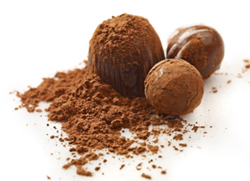 a permanent resident in the
pantheon of food fantasies. Chocolate truffles are
traditionally rough, cocoa-dusted balls of ganache named
so because of their similarity to the rare and greatly
prized mushroom truffles. In this issue, we equip you
with the knowledge and skills for devising your own
signature truffles. We'll demystify the magic behind
tempering chocolate and making ganache, while offering
tons of tips for successfully working with chocolate in
your own kitchen. We finish with three recipes for
truffles - each a great example of different
truffle-making methods. You'll be amazed at the ease of
fashioning your own truffles, and delighted at the
response of the lucky people you share them with - if
you share, that
is! a permanent resident in the
pantheon of food fantasies. Chocolate truffles are
traditionally rough, cocoa-dusted balls of ganache named
so because of their similarity to the rare and greatly
prized mushroom truffles. In this issue, we equip you
with the knowledge and skills for devising your own
signature truffles. We'll demystify the magic behind
tempering chocolate and making ganache, while offering
tons of tips for successfully working with chocolate in
your own kitchen. We finish with three recipes for
truffles - each a great example of different
truffle-making methods. You'll be amazed at the ease of
fashioning your own truffles, and delighted at the
response of the lucky people you share them with - if
you share, that
is!
|
Ken's Corner - February
Notes
|
I
don't know about you, but if I received a gift of
homemade chocolates for Valentine's Day, I'd feel pretty
special. Yes, it's a little tricky keeping the
temperature just right, but it's all very possible and
you'll love the results. I wish we had this information
a few years ago when Dagmar made a chocolate cake for
the desert competition of the Marietta YMCA's Chili
Cook-off. She managed to make the large chocolate curls
she needed only through trial and error. Having this
information about tempering would have saved her a lot
of time and frustration (the desert won a first place
just the same!).
Spring has sprung, well, sort
of. We've just unpacked a large shipment of Spring
linens from April Cornell. Bright patterns and
colors, table cloths and runners, placemats and napkins,
all 100% cotton. If you want to brighten up your kitchen
and get a little jump on the season, stop in and see if
we have a color that lifts your spirit.
We were a
little premature in hoping that our website would be up and running two
weeks ago. In actuality, it only went live Tuesday of
this week. Our store with cooking.com
is up and running, clicking on the shopping link on our
website will give you access to over 60,000 items for
your kitchen along with access to 1,000's of recipes.
It's a great resource and we urge you to try and take
advantage of it next time you need ideas or
inspiration.

| | |
|
Know
Your Chocolate
|
Long
revered as an aphrodisiac, we now know that chocolate is also
medicinal! The high antioxidant content of chocolate
qualifies it - at least in our minds - as a health food!
(1.5-ounces of bittersweet chocolate has the antioxidant value
of a 5-ounce glass of red wine). We've been chocophiles long
enough to become acutely aware of the differences between
chocolates and their nuances. Like other favorite
indulgences, (wine, coffee, etc.), chocolate reflects the land
on which it's been grown, how it's fermented and processed,
and how it's combined with other ingredients.
Great Beans - Chocolate is
derived from seeds harvested from the tropical cacao tree. The
seeds are encased in pulpy cacao pods. After the cacao pods
are harvested, the seeds and pulp are left to ferment for 3-7
days. The seeds are then extracted, roasted, and ground. The
ground seeds create a bean paste comprised of cocoa butter
(40-50%), and cocoa powder (50-60%). The bean paste is melted
to form chocolate liquor, a smooth, liquid slurry of the cocoa
butter and cocoa powder. Most chocolate manufacturers form
their confections from commoditized chocolate liquor. In the
U.S., 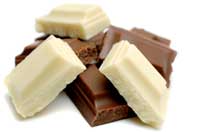 there are only twelve chocolate
makers that control their product "from bean to bar." there are only twelve chocolate
makers that control their product "from bean to bar."
Types of
Chocolate - Different chocolate preparations are often
defined by percentages. The percentages define the amount of
cacao bean in the product - that is, the proportion of the
chocolate that is cocoa butter and cocoa powder.
Milk chocolate -
30-40% cacao
Semi-sweet
chocolate - 55-60% cacao
Bittersweet
chocolate - 65-80% cacao
Unsweetened
chocolate - 99% cacao
Substituting Chocolate - Chef
Shotts, in the featured book below, recommends not
substituting a chocolate that varies more than 5% from what
the recipe specifies. Chef Alice Medrich notes that it is
possible to substitute bittersweet chocolate for semi-sweet
chocolate by decreasing the amount of chocolate by 10% and
adding 1 teaspoon of sugar for each ounce of chocolate
used.
Use High Quality
Chocolate - The greater the role of chocolate in the
final product, the more important it is to use high quality
chocolate. Beware of "wannabe" products sporting names like
"chocolate-flavored," or "chocolate-like."
|
Temper,
Temper
|
One of
our customers recently announced "I don't understand tempering
chocolate, so I just skip that step." She went on to lament,
"Why do my chocolates turn out dull and sticky?" Hmm.... Turns
out, there's a direct correlation between great results and
tempering the chocolate!
Tempering chocolate is worth
mastering and easier than you think. Tempering chocolate
involves heating chocolate and cooling it in such a way that
the crystalline structure of the chocolate is optimized.
Invisible to the eye, wonderful things are happening to the
chocolate as it is heated and cooled. Tempered chocolate
results in shiny, even surfaces that hardens well and stays
hardened at room temperature. In other words, tempered
chocolate behaves appropriately and performs nicely in the
kitchen. It's a step that you really can't skip!
How to
Temper Dark Chocolate:
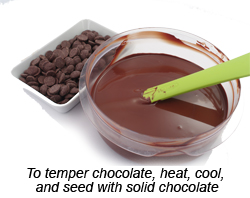 Tempering chocolate is about heating
chocolate and controlling how it cools. The tight temperature
management involved with tempering requires the instant
information available with today's digital thermometers.
Instant-read, digital thermometers take all of the mystery out
of tempering, and provide the essential magic for realizing
chocolate success every time. Tempering chocolate is about heating
chocolate and controlling how it cools. The tight temperature
management involved with tempering requires the instant
information available with today's digital thermometers.
Instant-read, digital thermometers take all of the mystery out
of tempering, and provide the essential magic for realizing
chocolate success every time.
Microwave
Method:
Step 1:
Melt - Place three-fourths of the dark chocolate to be
tempered in a heavy, microwavable bowl. (We like to use our
thick-walled chili bowls). Heat the chocolate 45-60 seconds at
a time on a 50% power setting. Stir the chocolate after each
minute until melted and smooth.
Step 2:
Heat - Heat the chocolate to a temperature of 115-120ºF. This
melting point dissolves the chocolate's crystalline structures
and sets the scene for proper re-crystallizing.
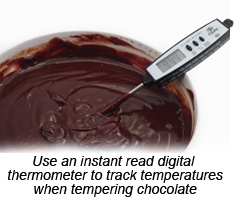 Step 3:
Cool - Allow the chocolate to cool to 95ºF with occasional
stirring. It won't take long for this cooling to
occur. Step 3:
Cool - Allow the chocolate to cool to 95ºF with occasional
stirring. It won't take long for this cooling to
occur.
Step 4:
Seed - At 95ºF, the chocolate is beginning to reform its
crystalline structure. Add some solid chocolate bits from the
remaining fourth of chocolate to the melted chocolate. The
solid chocolate will melt and provide "seed crystals" for the
cooling chocolate to form around. Continue to add the solid
chocolate bits until the chocolate reaches a temperature of
86ºF.
Step 5:
Reheat & Hold - Reheat the cooled, tempered chocolate ever
so slightly to 89ºF and hold at that temperature while dipping
or molding.
Double-Boiler
Method:
The same heating and cooling process can be
accomplished in a double boiler where the indirect heat from
the steam melts and heats the chocolate. Chocolate burns
easily -- at around 200ºF -- so placing the chocolate in a
saucepan directly on the stovetop is not an option.
Tempering Semi-Dark, Milk
or White Chocolates: Similar to dark
chocolate, other types of chocolate benefit greatly from the
tempering process. Follow the same process, but key in on the
different temperature points that characterize these other
chocolate forms.
|
Making
Ganache
|
A
chocolate ganache is deceptively easy to make for something
that is so incredible to eat! At it's basic form, ganache
(French origin, pronounced "GUH-nash"), is a mixture of
chocolate and cream. The cream integrates with the chocolate's
structure giving it a lighter, whipped-like texture. The
result is a bite of chocolate that rapidly dissolves in the
mouth giving new meaning to the common phrase, "melt in your
mouth."
Steps
for Making Ganache:
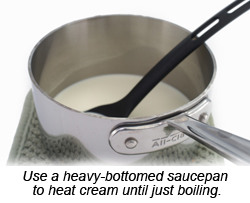 Step 1: Chop or shave
chocolate into small pieces. Small nuggets, the size of
traditional chocolate chips, are a good size. Place in a
small, deep bowl. Choose a bowl that will retain heat and that
can be micro-waved if necessary. (We like to use our chili
soup bowls for this step). Step 1: Chop or shave
chocolate into small pieces. Small nuggets, the size of
traditional chocolate chips, are a good size. Place in a
small, deep bowl. Choose a bowl that will retain heat and that
can be micro-waved if necessary. (We like to use our chili
soup bowls for this step).
Step 2:
Heat the cream in a small saucepan until it just begins to
boil. Watch carefully as cream can burn easily after this
point. Use a high quality pan that transfers heat efficiently
to prevent burning on the bottom. A common ganache ratio is
twice as much chocolate to cream by weight.
Step
3: Pour the heated cream over the chopped
chocolate waiting in the bowl. Let set for 5 minutes without
stirring or disturbing. (Do not put the chocolate 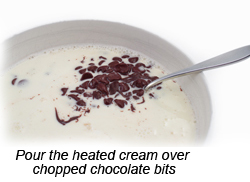 in the saucepan with the cream;
the pan will retain too much residual heat for the
mixture). in the saucepan with the cream;
the pan will retain too much residual heat for the
mixture).
Step 4:
Stir the chocolate and cream mixture gently until the two
become incorporated into a shiny, uniform mixture. The ganache
will thicken as it cools. Allow it to cool gradually to room
temperature; avoid the temptation to rush things by putting
the ganache in the refrigerator. Once at room temperature, the
ganache is ready for use or may be refrigerated until
needed.
Flavor
Variations: Add flavor to ganache through flavoring the
cream, (as with the raspberry puree in the Red Rose Truffles
below), or add flavors, (especially liqueurs and fragrant oils
as in the Grand Marnier Truffles below), when the ganache
temperature cools to 95ºF.
Working
with Ganache: Ganache is built to melt quickly in your
mouth and has a very low melting point compared to plain
chocolate. While delightful to eat, working with ganache can
be tricky. To form the ganache centers of truffles, try one of
these methods:
By Hand -
Scoop a small spoonful of thoroughly cooled, refrigerated
ganache. Roll in the palm of your hands quickly forming a
small round ball. 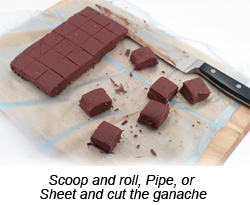 A very small ice cream scoop, or
melon baller may be quite useful in forming a ball that can be
finished off quickly by hand. Piping -
Alternatively, place cooled, (not refrigerated), ganache in a
piping or plastic bag. Squeeze out equal mounds of ganache on
a cookie sheet lined with wax or parchment paper. When cooled
further, balls of ganache can be easily rolled and
completed. Sheeted -
Ganache can be poured in a shallow pan, cooled, (even frozen),
until firm, then cut into squares or shape with small cookie
cutters. |
Smart
Chocolate Truffle Tips
|
Tip #1: Add just a
slight amount of cayenne pepper to the ganache mixture. In the
right quantity, the hot spice will be imperceptible as a
distinct taste, but will heighten the mouth's response to the
chocolate with a delightful "afterburn."
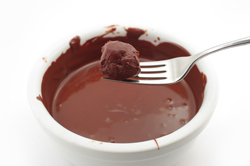 Tip #2: Use a variety
of coatings for rolled balls of ganache. Try chopped
pistachios, confectioner's sugar, toasted coconut, granulated
sugar with a splash of luster dust, a combination of dark
cocoa powder mixed with granulated sugar, sipping chocolate
powders - including the "hot," spicy sipping chocolates, or
finely crushed cacao nibs. Tip #2: Use a variety
of coatings for rolled balls of ganache. Try chopped
pistachios, confectioner's sugar, toasted coconut, granulated
sugar with a splash of luster dust, a combination of dark
cocoa powder mixed with granulated sugar, sipping chocolate
powders - including the "hot," spicy sipping chocolates, or
finely crushed cacao nibs.
Tip #3: To make
chocolate ruffles for decorating and garnishing, pour tempered
chocolate in a thin layer on top of an over-turned jelly roll
pan. Allow the chocolate to set slightly. With an offset
spatula, or other straight edge held at an angle, scrape the
chocolate off the jelly roll pan with an arc motion.
Temperature and practice will yield great chocolate ruffles
and a great frill to any dessert.
Tip #4: To keep
tempered chocolate at proper working temperature, use a
thick-walled bowl for your tempered chocolate. To further
maintain the temperature, form an insulating nest from folded
dishtowels to hold the bowl. Tempering machines are often
available for holding the chocolate at a constant low
temperature for large batches.
Tip #5: Take special care
once chocolate cools to its tempering point to reheat it only
slightly to its working temperature. If the reheated chocolate
becomes too hot, it loses its temper and its optimal
crystalline structure. If the chocolate becomes too hot,
repeat the cooling and seeding process to bring the chocolate
back into temper.
Tip
#6: Serve truffles at room temperature; 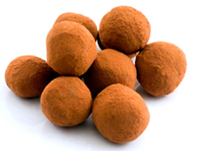 this will allow the delicate
flavors to bloom in the mouth and for the best texture and
mouth feel. Many truffles are perishable and should be kept
refrigerated, but wait 30 minutes before serving to allow them
to come to room temperature. this will allow the delicate
flavors to bloom in the mouth and for the best texture and
mouth feel. Many truffles are perishable and should be kept
refrigerated, but wait 30 minutes before serving to allow them
to come to room temperature.
Tip #7: Pair dark chocolate
desserts with robust, red wines. Avoid dessert wines that may
add too much sweetness to the
occasion.
|
Q
& A's
|
 Q: What are the whitish-gray
spots on my chocolate? Q: What are the whitish-gray
spots on my chocolate?
A: These surface spots
are known as "chocolate bloom" and appear when chocolate has
been improperly stored at some point in its life. 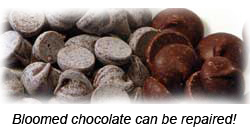 Chocolate bloom can arise from two
situations: fat bloom or sugar bloom. Fat bloom results from
slight melting and separation of the chocolate components on
the surface. The white spots are re-crystallized cocoa butter.
Sugar bloom occurs in conditions of heavy humidity. The water
dissolves some of the sugar in the chocolate and as the
chocolate re-dries, the sugar re-crystallizes on the surface.
Chocolate with "bloom" may not look great, but it will not
affect its taste, use, or performance. The chocolate bloom
will disappear when the chocolate is re-tempered. Chocolate bloom can arise from two
situations: fat bloom or sugar bloom. Fat bloom results from
slight melting and separation of the chocolate components on
the surface. The white spots are re-crystallized cocoa butter.
Sugar bloom occurs in conditions of heavy humidity. The water
dissolves some of the sugar in the chocolate and as the
chocolate re-dries, the sugar re-crystallizes on the surface.
Chocolate with "bloom" may not look great, but it will not
affect its taste, use, or performance. The chocolate bloom
will disappear when the chocolate is re-tempered.
Q: What is white
chocolate?
A: The ground, roasted cacao beans
have two components: cocoa powder and cocoa butter. Most
chocolate uses both items, where white chocolate uses only the
cocoa butter portion of the bean. Like other chocolate, sugar,
milk, and vanilla are added to the cocoa butter to make the
white chocolate we purchase.
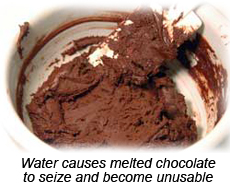 Q: My smooth, melted chocolate just
turned grainy and hard. What happened? Q: My smooth, melted chocolate just
turned grainy and hard. What happened?
A:
Your chocolate just "seized." The melted
chocolate contacted a drop of water. It may be a random drop,
or steam condensate from your double boiler (which is why a
microwave is so nice to use). As discussed above, chocolate
has an intricate crystalline structure. The introduction of
water "inspires" the mixture to form crystals around the water
instead of the seed chocolate. Aberrant crystals form
immediately creating a grainy, stiff mess. There's no recourse
for chocolate that's seized - start
over!
|
Cookbook
Review
|
Making
Artisan Chocolates, Flavor-Infused Chocolates, Truffles, and
Confections by Andrew Garrison Shotts. Photography by
Madeline Polss. Copyright 2007. Published by Quarry Books, a
member of Quayside Publishing Group, Gloucester, MA.
Andrew
Garrison Shotts - Winner of the Food Network 2007 Hot
Chocolate Award
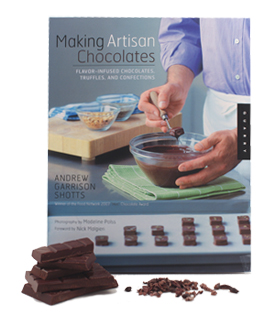 This book is basic and advanced all in
one cover. If you've ever desired to know the secrets of
boutique handcrafted chocolates, they are revealed in these
pages. Mr. Shotts knows his chocolate, and also knows how to
communicate his knowledge and passion about working with
chocolate. He starts with a primer about chocolate, where it
comes from, how cacao beans are transformed into chocolate,
and then sets the table for working in flavors, best pairings
and elegant presentations. The recipe portion of the book is
divided into four working chapters: Truffles, Molded
Chocolates, Hand-Dipped Chocolates, and Fun Chocolate
Confections. Each recipe is expertly presented with special
tutoring provided for each step of the process. We love the
fact that the amount of each ingredient is expressed by both
volume and by weight. (We love cooking by weight measurements
whenever we can - it's so much easier, more accurate, and with
less clean-up). The lavish photography throughout the book
provides great visual inspiration as well as concrete
guidance. You'll enjoy the unique flavor combinations in the
presented recipes, and will close the back cover with the
confidence to experiment on your own in creating and crafting
upscale
chocolates. This book is basic and advanced all in
one cover. If you've ever desired to know the secrets of
boutique handcrafted chocolates, they are revealed in these
pages. Mr. Shotts knows his chocolate, and also knows how to
communicate his knowledge and passion about working with
chocolate. He starts with a primer about chocolate, where it
comes from, how cacao beans are transformed into chocolate,
and then sets the table for working in flavors, best pairings
and elegant presentations. The recipe portion of the book is
divided into four working chapters: Truffles, Molded
Chocolates, Hand-Dipped Chocolates, and Fun Chocolate
Confections. Each recipe is expertly presented with special
tutoring provided for each step of the process. We love the
fact that the amount of each ingredient is expressed by both
volume and by weight. (We love cooking by weight measurements
whenever we can - it's so much easier, more accurate, and with
less clean-up). The lavish photography throughout the book
provides great visual inspiration as well as concrete
guidance. You'll enjoy the unique flavor combinations in the
presented recipes, and will close the back cover with the
confidence to experiment on your own in creating and crafting
upscale
chocolates.
|
Three
Terrific Truffles!
|
Recipes excerpted from Making
Artisan Chocolates by Andrew Garrison Shotts. Copyright
2007. Published by Quarry Books, a member of Quayside
Publishing Group, Gloucester, MA. Reprinted with permission of
the publisher. All rights reserved.
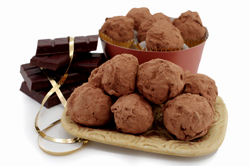 Truffles - Classic Dark 72
Percent Truffles - Classic Dark 72
Percent
"Classic" is the
perfect term for these dusty jewels! Deep, dark chocolate is
showcased in this recipe for truffles. The depth of chocolate
flavor cannot be underestimated. The thin chocolate shell
encases a ganache that melts in your mouth releasing a
concentrated essence of chocolate. Making truffles is
deceptively easy; start here with this basic recipe, then
apply your creativity from here. (Looking for simple? Just
make the ganache and roll in your favorite coating - no
tempering or chocolate shell necessary).
Click here to view the
full, illustrated recipe.
Click here for a printable
version of the recipe. (PDF
format)
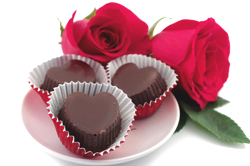 Red Rose Molded
Chocolates Red Rose Molded
Chocolates
A perfect Valentine's gift, (or
really anytime), these Red Rose truffles are a great example
of molded chocolate shells with a ganache filling. The ganache
is flavored with raspberry puree, a classic flavor to pair
with chocolate. The raspberry essence comes through the dark
chocolate context in a very subtle, yet unmistakable, fashion.
Definitely the food of love!
Click here to view the
full, illustrated recipe.
Click here for a printable
version of the recipe. (PDF
format)
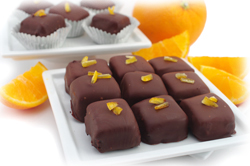 Hand-Dipped Grand Marnier
Chocolates Hand-Dipped Grand Marnier
Chocolates
Rich flavors exude from these
little squares. The Grand Marnier liqueur and the orange oil
lend a fresh citrus taste to the deep, dark chocolate. A great
example of a third way to make truffles, the firmed up ganache
is cut into squares, dipped in tempered chocolate, and
garnished with a bit of candied orange peel. We received no
complaints, only plenty of contented sighs!
Click here to view the
full, illustrated recipe.
Click here for a printable
version of the recipe. (PDF
format)
| |
| Indulge
your chocolate passions!
|
|
| |